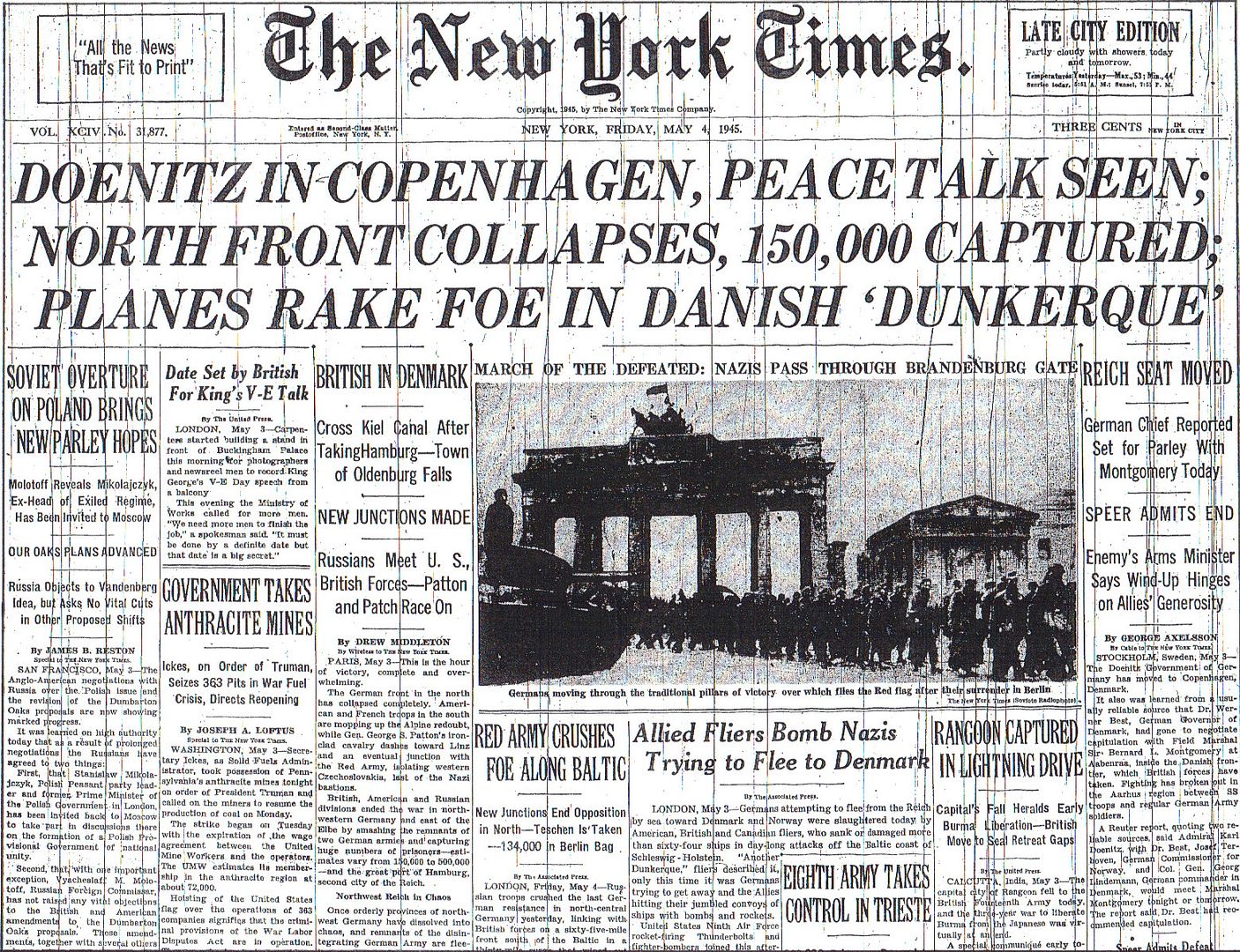
Posted on 05/04/2015 4:19:25 AM PDT by Homer_J_Simpson


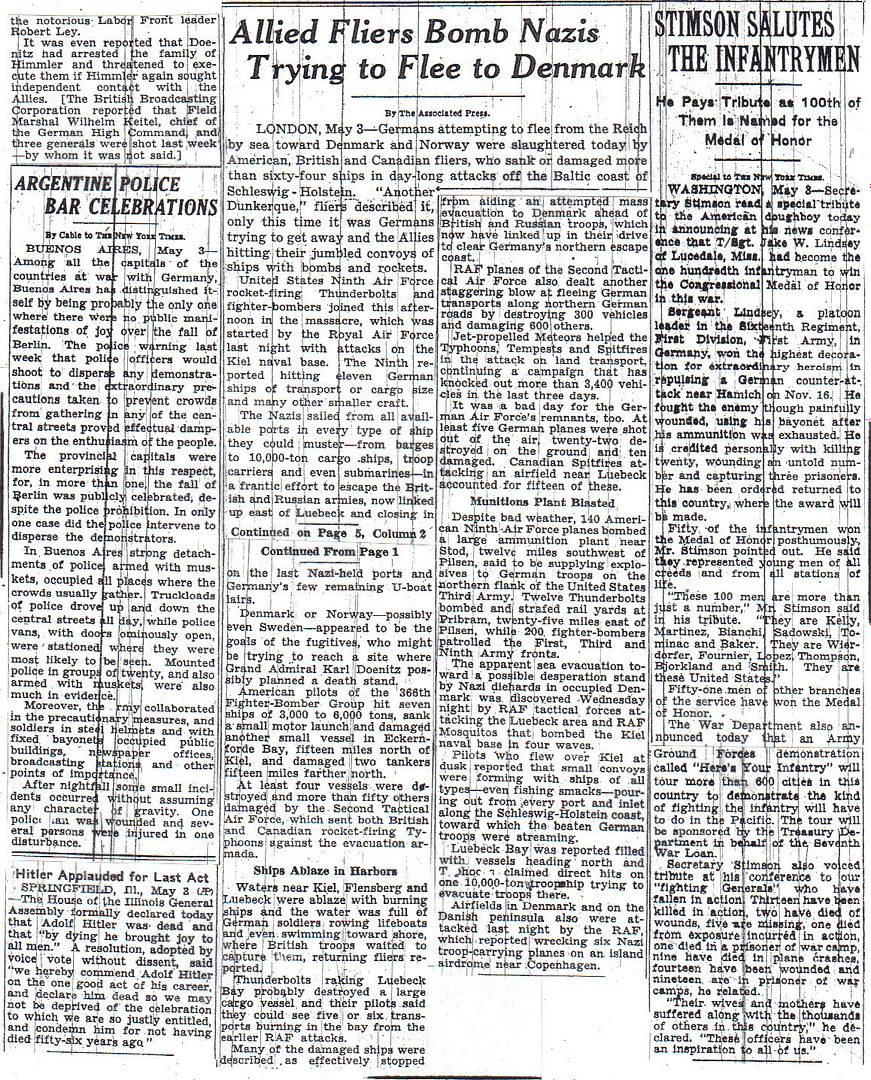
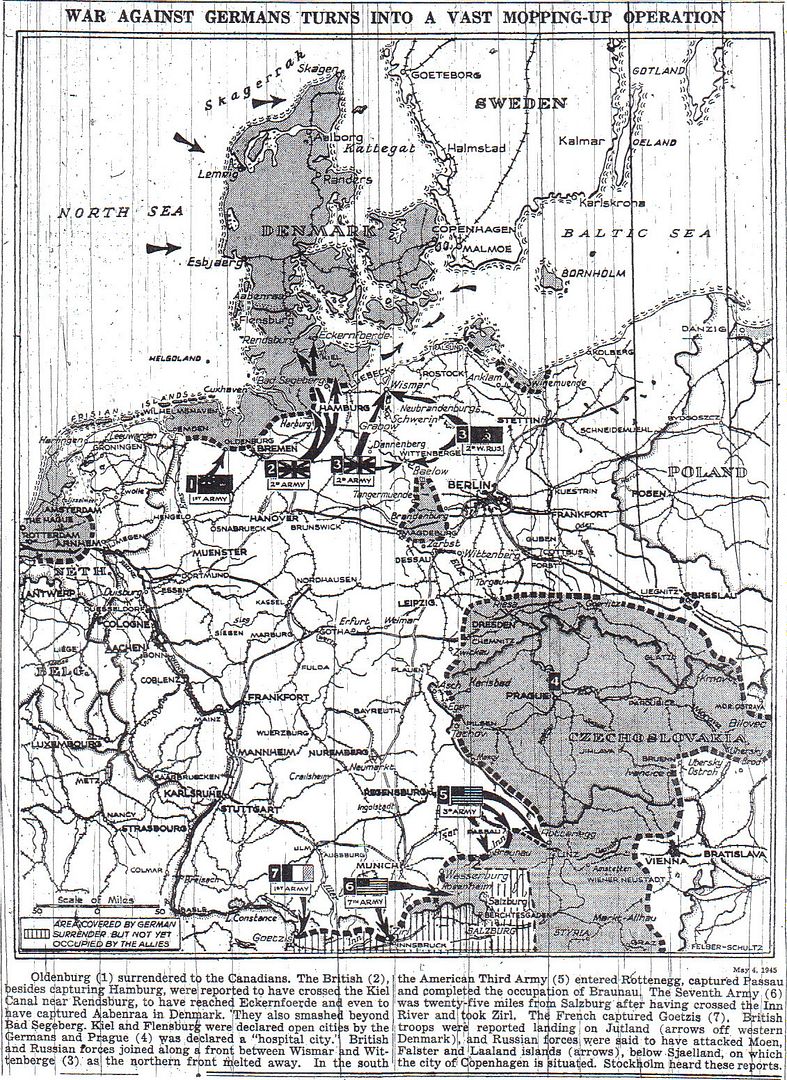
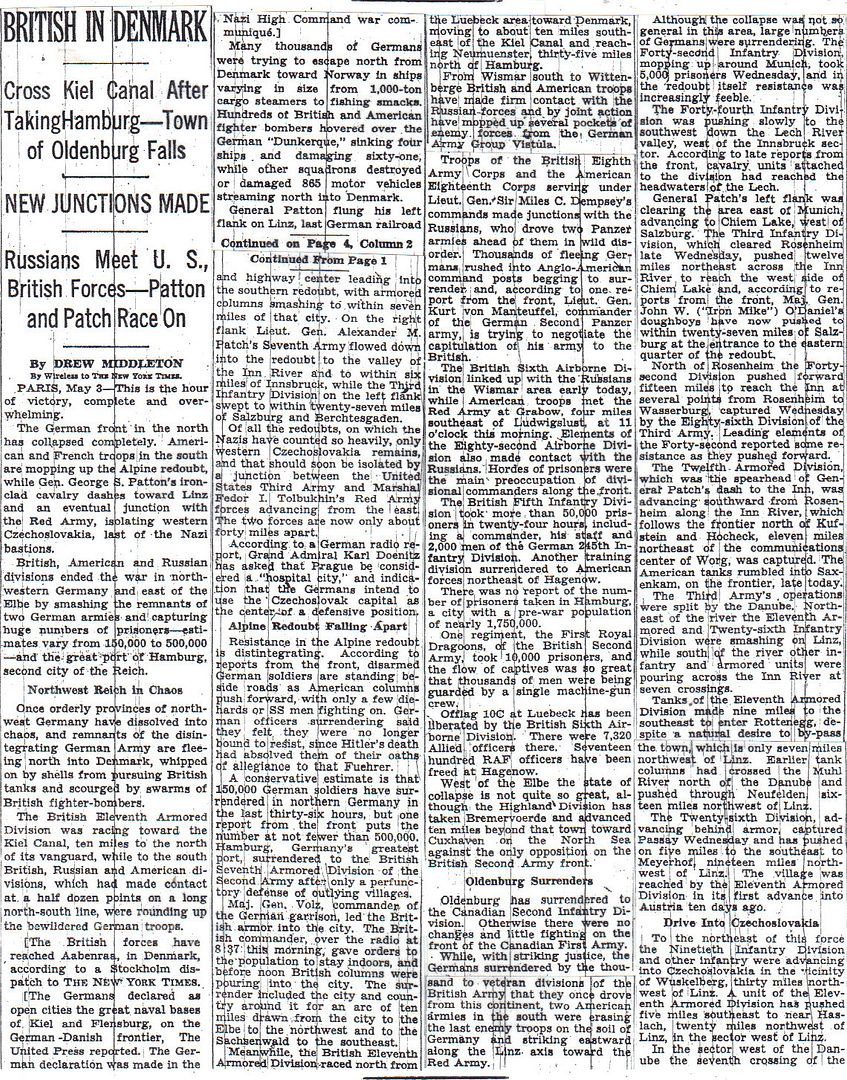
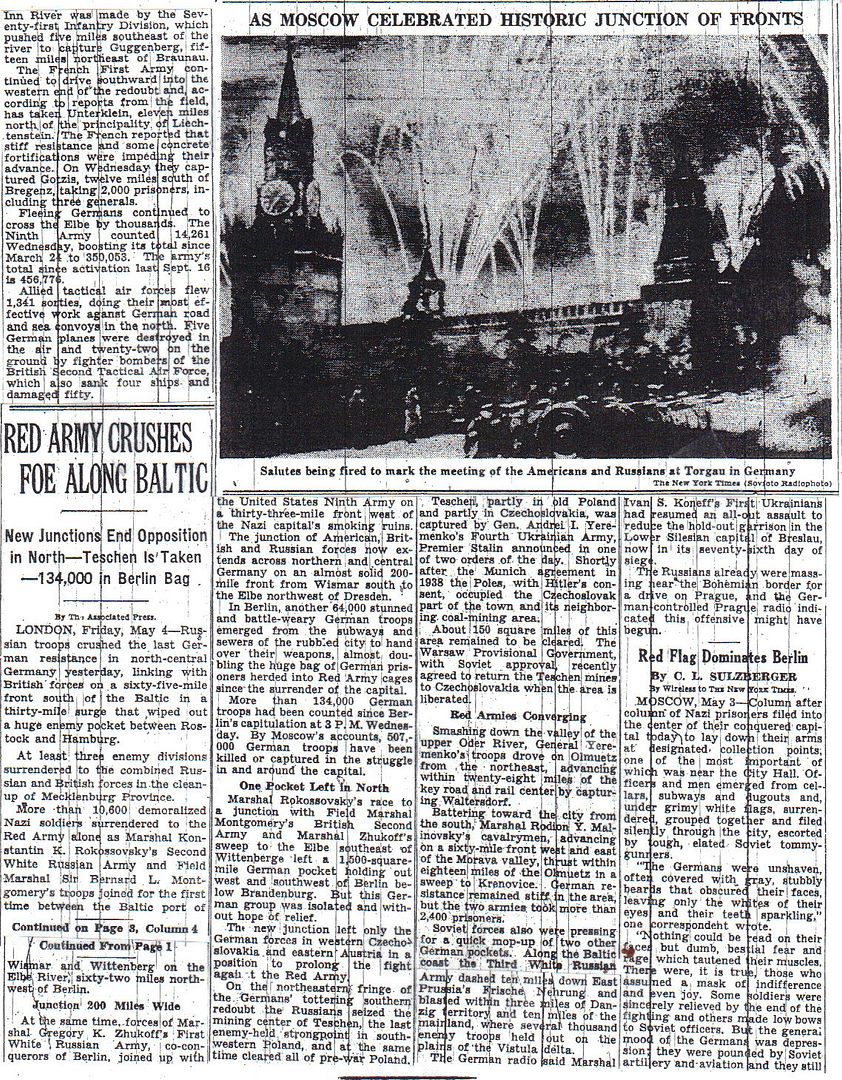
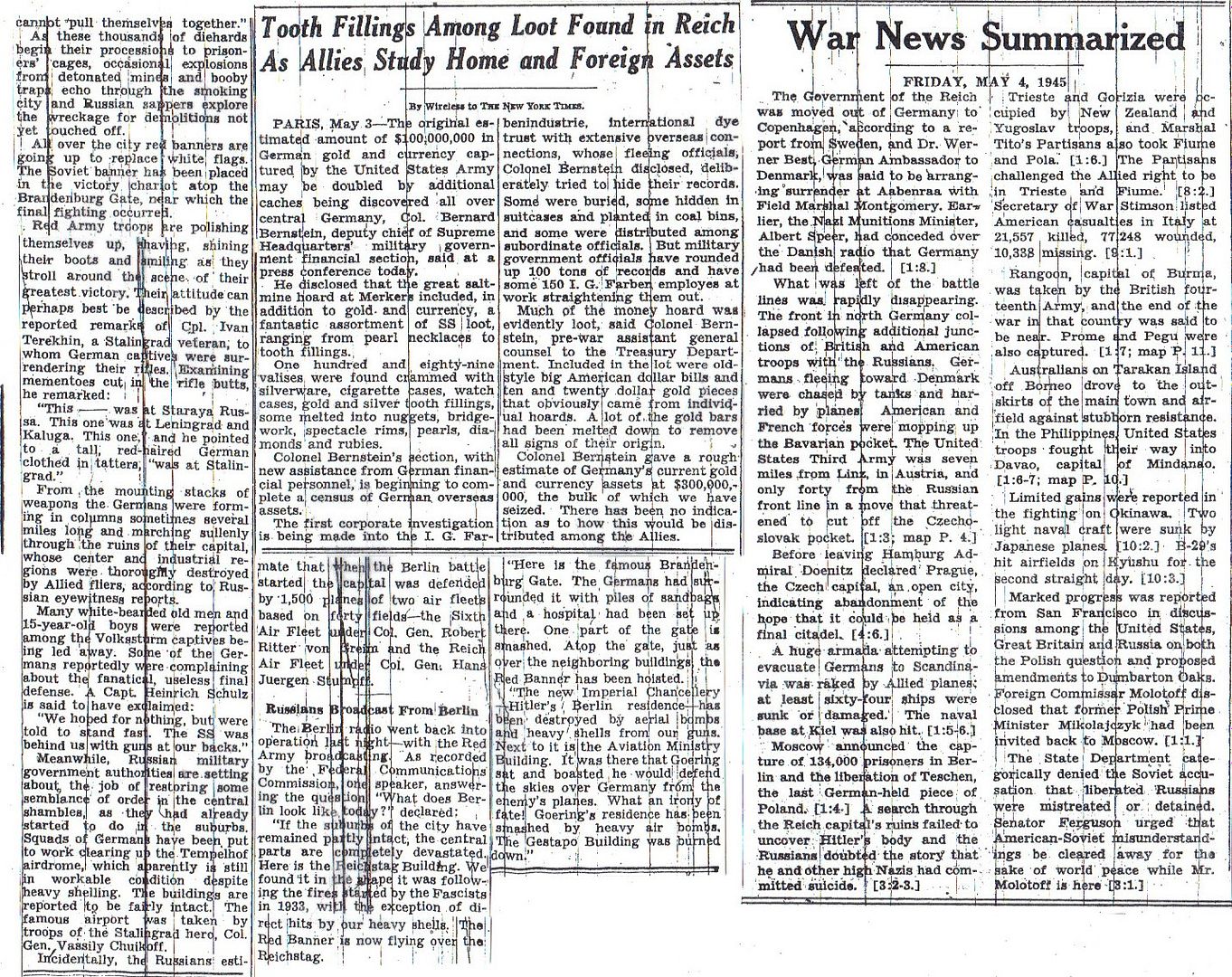
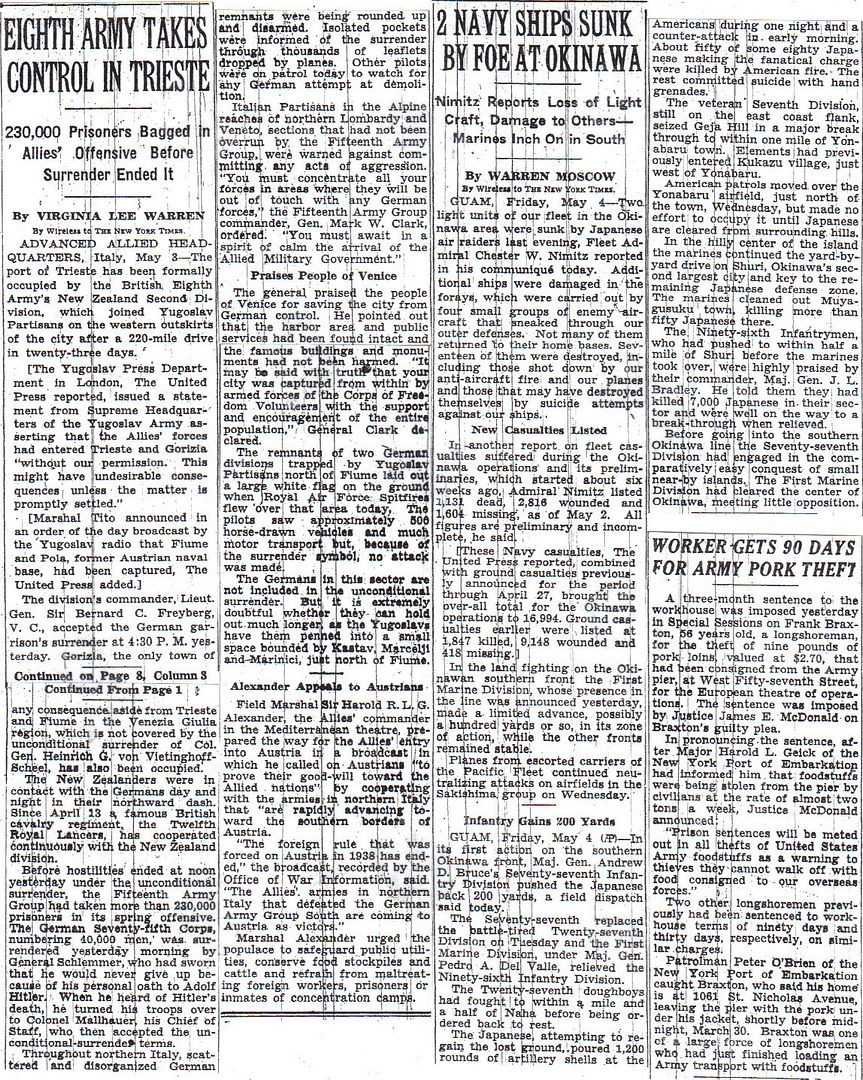
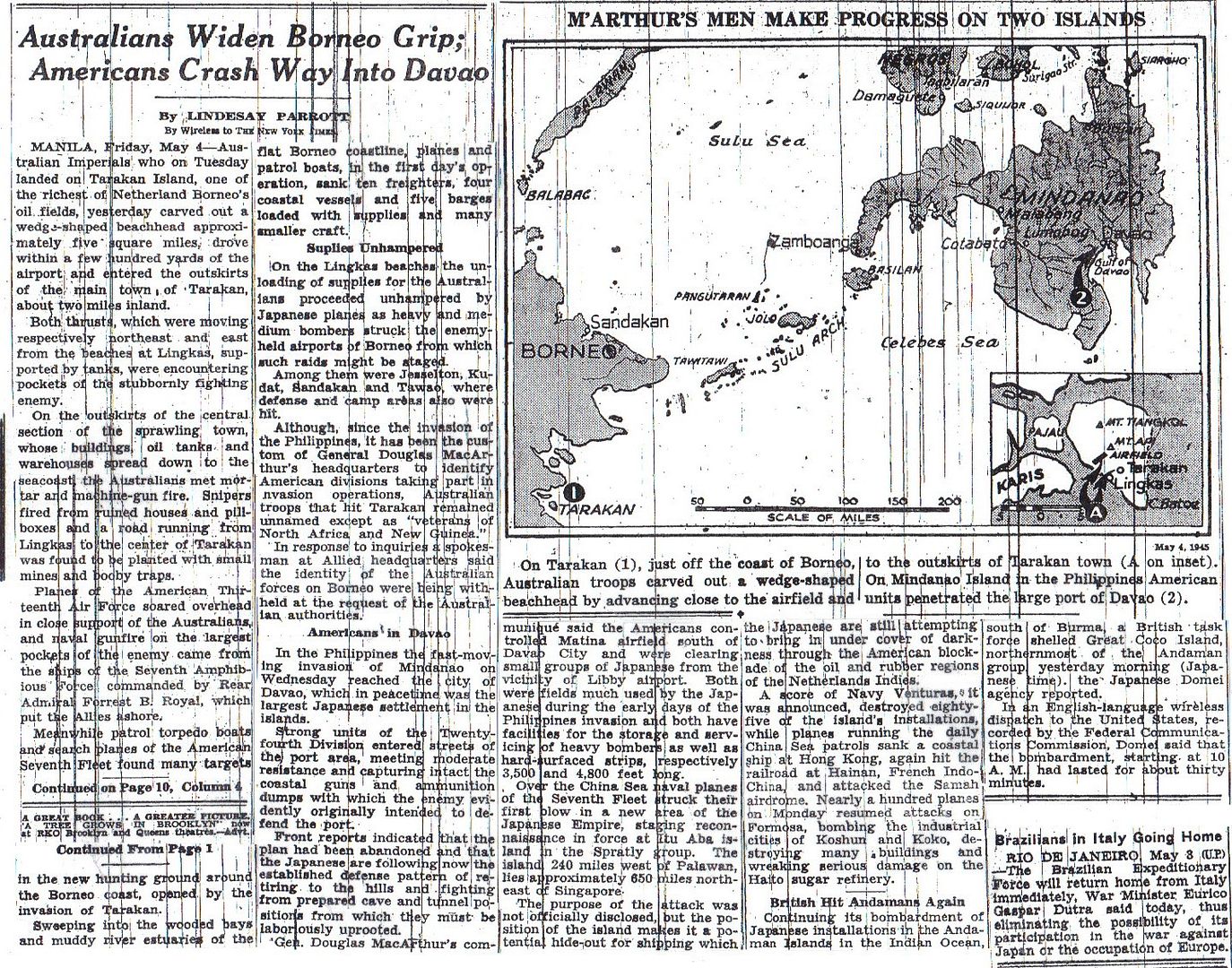
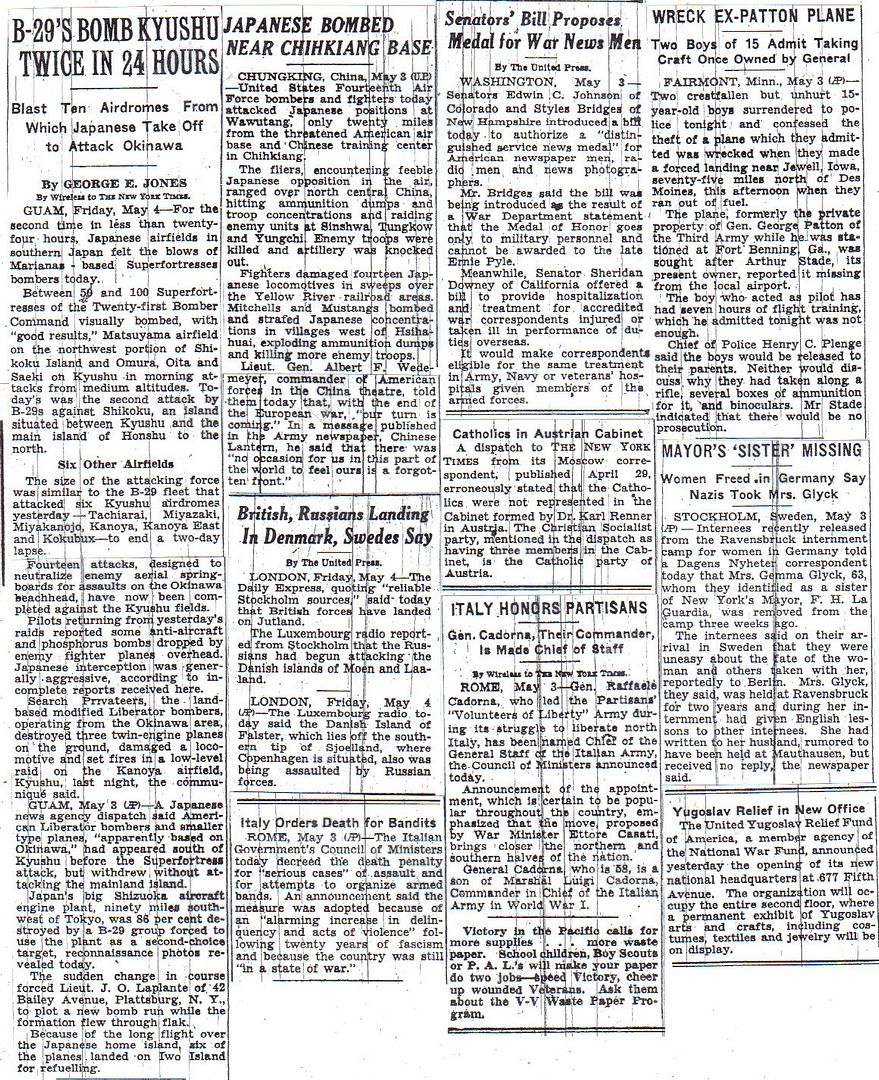
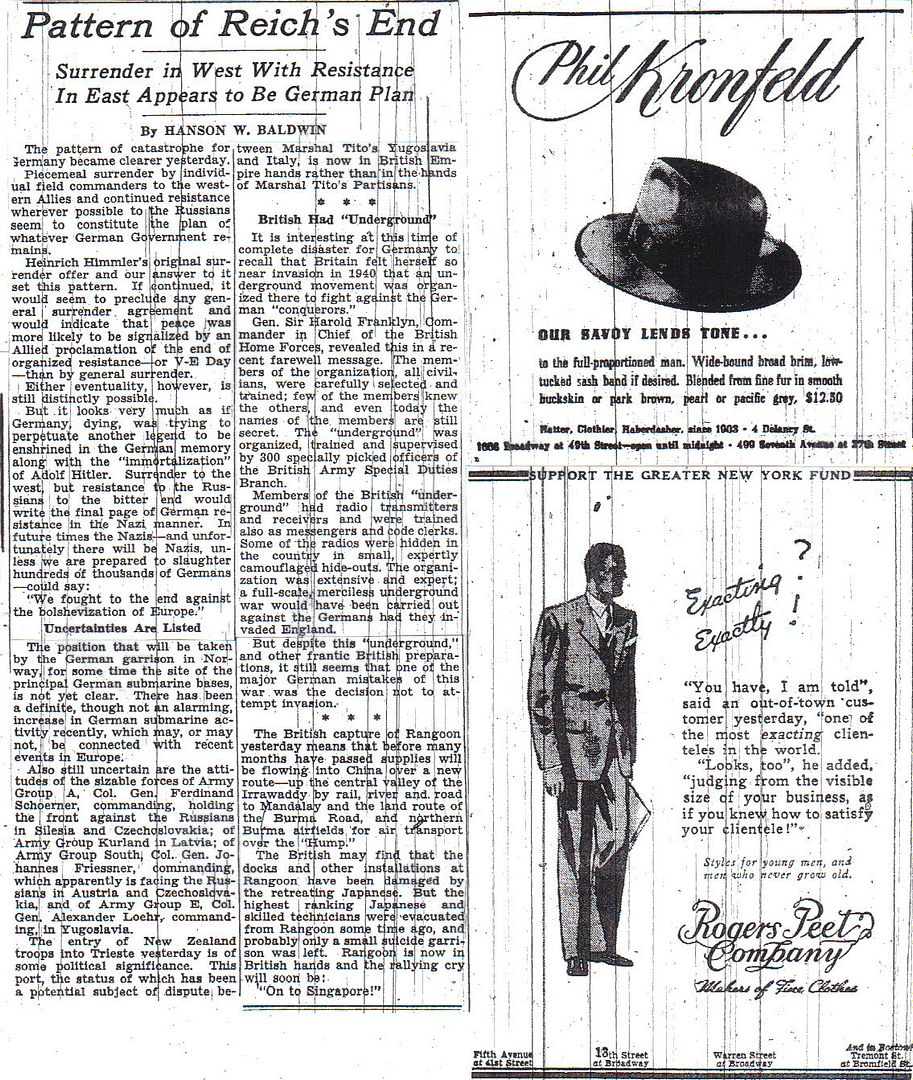
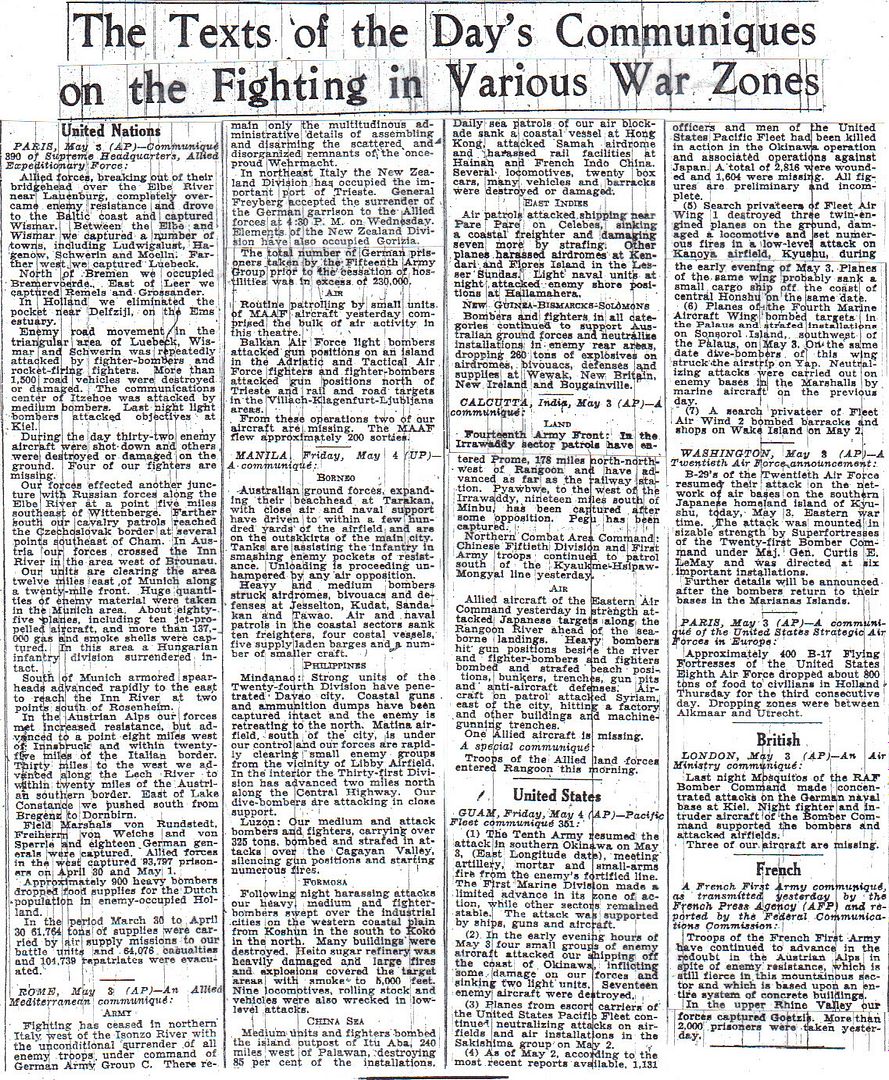
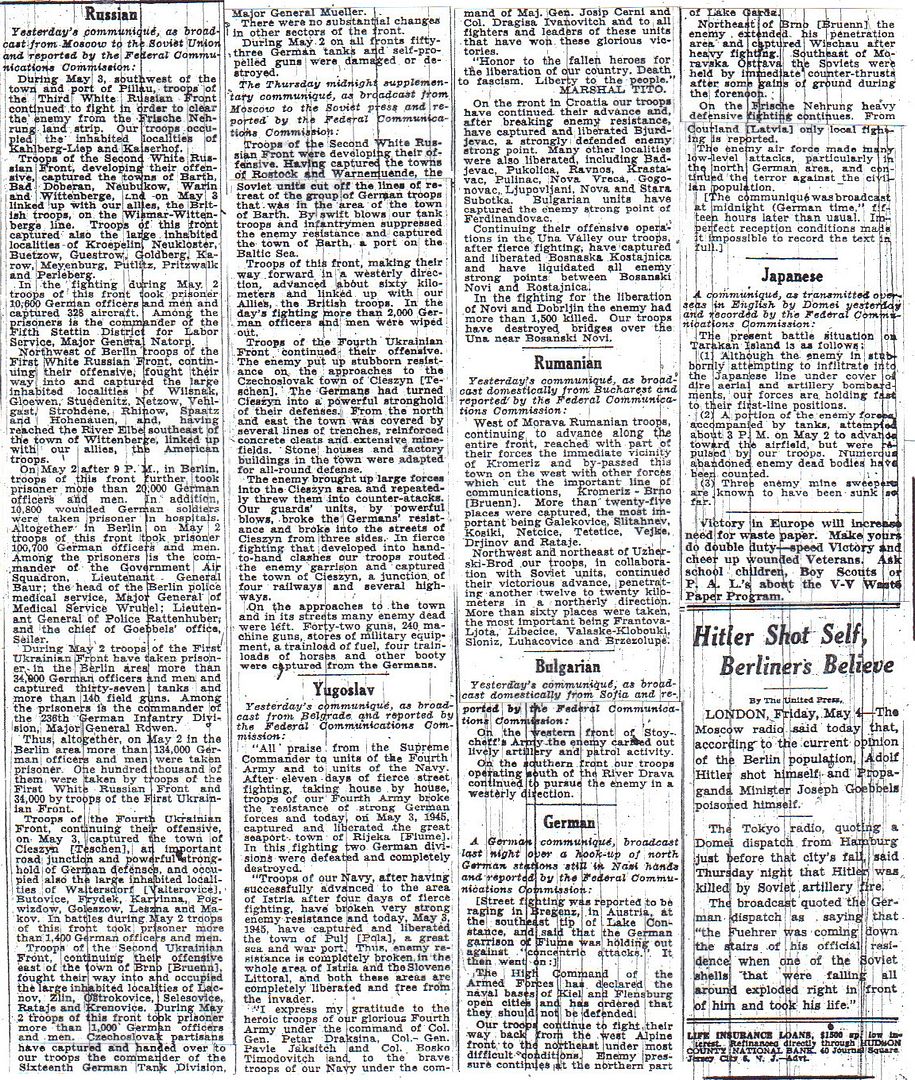
http://www.etherit.co.uk/month/4/04.htm
May 4th, 1945 (FRIDAY)
GERMANY: Doenitz sends envoys to Montgomery’s HQ at Lüneburg Heath to arrange for the surrender of Holland, Denmark and north Germany. This surrender will be effective at 0800 on May 5.
Lüneburg Heath: In a tent on the desolate Lüneburg Heath, three generals and two admirals this evening put their signatures to the surrender of all German armed forces in north-west Germany, the Netherlands and Denmark. As Montgomery read out the capitulation terms, a nervous German general took out a cigarette; Monty, who disapproves of smoking, gave him a sharp glance and the German hastily pit it away. The German team was led by an Admiral, Hans Georg von Friedeburg; he first appeared yesterday to ask Montgomery to accept the surrender of three Panzer armies which were retreating from the Russians, and to allow civilians fleeing from the Russians to pass through the British lines.
“No, certainly not,” Montgomery said. He told von Friedeburg to go back to Dönitz and tell him that the armies fighting the Russians must surrender to them. As for the civilians, he would discuss that question after the surrender. He then produced a map of the battle situation. “That was a great shock to them,” Montgomery says. He sent the Germans off to have lunch in a separate tent; throughout the meal von Friedeburg was in tears. The surrender takes effect from 8am tomorrow. More than 500,000 troops are involved; these will join the 500,000 taken prisoner in the past 24 hours.
Tonight von Friedeburg and his fellow officers are sleeping at Montgomery’s HQ; tomorrow they will be taken to Eisenhower’s HQ at Rheims for more surrender talks. Montgomery, a teetotaller, this evening relaxed and drank a glass of champagne.
The only “kill” attributed to the Volksjaeger FG-1 flying the Heinkel 162 jet is that of I/JG1’s Lt.Rudolf Schmitt today for a low-flying RAF Typhoon. This claim has since been attributed to flak. (Russ Folsom)
German troops in Berlin try to reach the US and British lines, rather than be taken by the Russians.
Troops of the US First Army prepare to march into Czechoslovakia.
AUSTRIA: Salzburg is taken by US forces, who then move on towards Berchtesgaden.
Units of the US 3rd Army complete the crossing of the river Inn, and Innsbruck finally surrenders.
The last Me-109G fighters of the Hungarian Air Force under de Heppe, are destroyed by strafing P-51s. (Mike Yaklich)
GULF OF SIAM: USS Lagarto, a 1,500 tonne ‘Balao class’ submarine disappears after attacking a Japanese tanker and destroyer convoy around 100 miles off the southeast coast of Thailand. (Will O’Neil)
JAPAN: Okinawa: Fighting rages across southern Okinawa as Gen Ushijima’s Thirty-second Army launches a damaging attack using tanks. US positions were hit by a 13,000-shell bombardment followed by suicidal infantry attacks. Offshore, Kamikaze boat and plane raids sank 17 US ships and damaged 11 others, with 682 US dead; but four daring sea raids by Japanese commandos behind US lines were all beaten back. Japanese losses are estimated at 5,000 dead; 131 aircraft have been lost.
Kamikazes sink the destroyers USS Luce (DD-522) and USS Morrison (DD-560) and two medium landing craft (LSMs); the kamikazes also damage the aircraft carrier HMS Formidable; light cruiser USS Birmingham (CL-62); escort aircraft carrier USS Sangamon (CVE-26); destroyers USS Ingraham (DD-694, USS Cowell (DD-547) and USS Lowry (DD-770); light minelayer USS Gwin (DM-33); high-speed minesweeper USS Hopkins (DMS-13); and a motor minesweeper (YMS). The Japanese also launch Yokosuka MXY7 Navy Suicide Attacker Ohka (Cherry Blossom) Model 11 rocket-propelled glide bombs known as “Baka;” they damage the light minelayer USS Shea (DM-30); and minesweeper USS Gayety (AM-239) which is also attacked by a kamikaze.
The British carrier HMS FORMIDABLE is damaged by a kamikaze attack off the Sakishima Islands.
CANADA: Frigate HMCS Teme paid off and returned to RN as constructive total loss for disposal. Scrapped Llanelly, Wales in 1946.
U.S.A.: The British film “The Life and Death of Colonel Blimp,” which had been released in the U.K. in June 1943, is released in the U.S. Directed by Michael Powell and Emeric Pressburger, the film stars Deborah Kerr and follows the life of a British soldier from the Boer War to WWII.
ATLANTIC OCEAN: Motor tanker Empire Unity damaged by U-979 at 64.23N, 22.37W.
U-711 sunk in the Arctic near Harstad, Norway, in position 68.43,717N, 16.34,600E, by depth charges from Avenger and Wildcat aircraft of escort carriers HMS Searcher, Trumpeter and Queen. 40 dead and 12 survivors.
U-2338 sunk ENE of Frederica, position 55.34N, 09.49E, by RAF 236 and 254 Sqn Beaufighters. 12 dead and 1 survivor.
U-155 shot down an RAF 126 Sqn Mustang.
U-2511, a new Type XXI Elektroboot evades a destroyer screen to close within 500 metres of the British cruiser HMS Norfolk without being picked up by sonar. Commander Korvettenkapitän Adalbert Schnee goes through the preparations for firing his torpedoes, lines up the target ... and then withdraws without attacking. Schnee had received the cease-fire order a few hours earlier.
Imagine what would happen today.
The boys were indeed "crestfallen", according to the article, and likely the authorities deemed that to be punishment enough. Next time these boys commandeer a plane, they will be more careful not to ditch it.
http://www.uboat.net/fates/at-sea.htm
U-boats at sea on May 4, 1945
During the morning hours (German time) of May 4th 1945 the following signal was sent to all U-boat commanders:
ALL U-BOATS. ATTENTION ALL U-BOATS.
CEASE-FIRE AT ONCE. STOP ALL HOSTILE ACTION AGAINST ALLIED SHIPPING.
DÖNITZ.
The following U-boats were at sea when the order above came from Dönitz. Below are they all listed, when they left port and to which port they came to surrender.
[DL] means that this U-boat ended her career during Operation Deadlight.
Boat Sailed Patrol end Notes (surrender location, etc.)
U-190 19 Feb 1945 14 May 1945 Bay of Bulls, Canada
U-218 22 Mar 1945 12 May 1945 Bergen, Norway [DL]
U-234 16 Apr 1945 19 May 1945 Portsmouth, USA
U-244 15 Apr 1945 14 May 1945 Loch Eriboll, UK [DL]
U-245 9 Apr 1945 9 May 1945 Bergen, Norway [DL]
U-249 3 Apr 1945 10 May 1945 Portland, UK [DL]
U-255 5 May 1945 7 May 1945 St.Nazaire, France [DL]
U-255 8 May 1945 17 May 1945 Loch Eriboll, UK [DL]
U-278 10 Apr 1945 9 May 1945 Narvik [DL]
U-287 29 Apr 1945 16 May 1945 Sunk
U-293 1 Apr 1945 11 May 1945 Loch Eriboll, UK [DL]
U-295 15 Apr 1945 7 May 1945 Narvik [DL]
U-312 16 Apr 1945 8 May 1945 Kilbotn [DL]
U-313 17 Apr 1945 8 May 1945 Narvik [DL]
U-318 1 May 1945 10 May 1945 Narvik [DL]
U-320 27 Apr 1945 8 May 1945 Sunk
U-363 18 Apr 1945 8 May 1945 Narvik [DL]
U-481 7 Apr 1945 4 May 1945 Narvik [DL]
U-485 29 Apr 1945 14 May 1945 Gibraltar [DL]
U-516 5 Apr 1945 14 May 1945 Loch Eriboll, UK [DL]
U-530 3 Mar 1945 10 Jul 1945 Mar del Plata, Argentina
U-532 13 Jan 1945 13 May 1945 Loch Eriboll, UK [DL]
U-534 5 May 1945 5 May 1945 Sunk
U-541 7 Apr 1945 12 May 1945 Gibraltar [DL]
U-739 1 Apr 1945 13 May 1945 Emden, Germany [DL]
U-764 26 Apr 1945 14 May 1945 Loch Eriboll, UK [DL]
U-776 22 Mar 1945 16 May 1945 Portland, UK [DL]
U-802 28 Apr 1945 11 May 1945 Loch Eriboll, UK [DL]
U-805 17 Mar 1945 15 May 1945 Portsmouth, USA
U-825 1 Apr 1945 13 May 1945 Loch Eriboll, UK [DL]
U-826 9 Mar 1945 11 May 1945 Loch Eriboll, UK [DL]
U-853 23 Feb 1945 6 May 1945 Sunk
U-858 11 Mar 1945 14 May 1945 Lewes, Delaware, USA
U-873 30 Mar 1945 16 May 1945 Portsmouth, USA
U-881 7 Apr 1945 6 May 1945 Sunk
U-889 5 Apr 1945 13 May 1945 Shelbourne, Canada
U-901 14 Apr 1945 15 May 1945 Stavanger, Norway [DL]
U-907 29 Apr 1945 5 May 1945 Bergen, Norway [DL]
U-956 2 Apr 1945 13 May 1945 Loch Eriboll, UK [DL]
U-963 23 Apr 1945 20 May 1945 Scuttled
U-968 21 Apr 1945 6 May 1945 Harstad [DL]
U-968 7 May 1945 7 May 1945 Skjomenfjord [DL]
U-977 2 May 1945 17 Aug 1945 Mar del Plata, Argentina
U-979 29 Mar 1945 24 May 1945 Scuttled
U-992 1 May 1945 9 May 1945 Narvik, Norway [DL]
U-1005 3 May 1945 14 May 1945 Bergen, Norway [DL]
U-1009 29 Mar 1945 10 May 1945 Loch Eriboll, UK [DL]
U-1010 15 Apr 1945 14 May 1945 Loch Eriboll, UK [DL]
U-1023 25 Mar 1945 10 May 1945 Portland, UK [DL]
U-1058 28 Apr 1945 10 May 1945 Loch Eriboll, UK
U-1105 12 Apr 1945 10 May 1945 Loch Eriboll, UK
U-1109 17 Apr 1945 12 May 1945 Loch Eriboll, UK [DL]
U-1163 15 Apr 1945 9 May 1945 Kristiansand-Süd, Norway [DL]
U-1165 21 Apr 1945 5 May 1945 Narvik [DL]
U-1228 14 Apr 1945 17 May 1945 Portsmouth, USA
U-1231 27 Apr 1945 14 May 1945 Loch Eriboll, UK
U-1272 29 Apr 1945 10 May 1945 Bergen, Norway [DL]
U-1277 21 Apr 1945 3 Jun 1945 Scuttled
U-1305 4 Apr 1945 10 May 1945 Loch Eriboll, UK
U-2324 2 Apr 1945 8 May 1945 Stavanger, Norway [DL]
U-2326 4 May 1945 14 May 1945 Dundee, Scotland
U-2336 1 May 1945 14 May 1945 Kiel, Germany [DL]
U-2511 3 May 1945 6 May 1945 Bergen, Norway [DL]
U-3008 3 May 1945 21 May 1945 Kiel, Germany
64 U-boats were at sea on May 4, 1945 when the End-Hostilities order was given.
56 surrendered in Allied or neutral ports (41 of them were scuttled in Operation Deadlight).
U-boats lost at sea after May 4, 1945
The cease-fire order sent to U-boats on May 4 did not automatically mean that all hostilities were over. In fact at least 294 German sailors were lost with their U-boats on or after that date. Not all U-boats did receive the order properly and they did continue to sink ships until 7 May.
U-boat Date Crew Dead Survivors
U-711 4 May 47 32 15
U-2338 4 May 17 12 5
U-2503 4 May 57 13 44
U-2521 4 May 57 44 13
U-2367 5 May 17 0 17
U-534 5 May 52 3 49
U-579 5 May 48* 24 24*
U-3523 5 May 58 58 0
U-1008 6 May 44 0 44
U-881 6 May 53 53 0
U-853 6 May 55 55 0
U-320 8 May 47 0 47
* At least 24 dead, unknown number of survivors.
The Numbers
156 German U-boats surrendered to the the Allies at the end of the war. The Germans scuttled 219 U-boats near the end of the war to prevent them from falling into Allied hands.
The Third Reich thus had 375 U-boats available at the end of the war.
May 1945: “Operation Sunrise”, Nazi Germany Surrenders, But… on May 7, 8, or 9?
After the Casablanca Conference of January 1943, the Americans, British, and Soviets had agreed that there would be no separate negotiations with Nazi Germany with respect to its capitulation, and that the Germander surrender would have to be unconditional. In the early spring of 1945, Germany was as good as defeated and the Allies were getting ready to receive its capitulation. The expected unconditional German capitulation vis-à-vis all three Allies would have to be concluded somewhere, but where – on the Eastern Front, or on the Western Front?
If only for reasons of prestige, the Western Allies preferred that this would happen on the Western Front. Secret talks with the Germans, which the British and Americans were holding at that time (i.e. in March 1945) in neutral Switzerland, code-named Operation Sunrise, were useful in that context, not only with an eye on a German surrender in Italy, which had actually led to the talks, but also in view of the coming general and supposedly unconditional German capitulation, of which intriguing details – such as the venue of the ceremony – might possibly be determined in advance and without input from the the Soviets. There were many possibilities in this respect, because the Germans themselves kept approaching the Americans and the British in the hope of concluding a separate armistice with the Western powers or, if that would prove impossible, of steering as many Wehrmacht units as possible into American or British captivity by means of “individual” or “local” surrenders, i.e. surrenders of larger or smaller units of the German army in restricted areas of the front.
The Great War of 1914-1918 had ended with a clear and unequivocal armistice, namely in the form of an unconditional German surrender, which everybody knows went into effect on the eleventh hour of the eleventh day of the eleventh month of 1918. The Second World War, on the other hand, was to grind to a halt, in Europe at least, amidst intrigue and confusion, so that even today there are many misconceptions regarding the time and place of the German capitulation. The Second World War was to end in the European theatre not with one, but with an entire string of German capitulations, with a veritable orgy of surrenders.
It started in Italy on April 29, 1945, with the capitulation of the combined German armies in southwestern Europe to the Allied forces led by Alexander, the British field marshal. Signatories on the German side included SS General Karl Wolff, who had conducted the negotiations with American secret agents in Switzerland about sensitive issues such as the neutralization of the kind of Italian anti-fascists for whom there was no room in the American-British post-war plans for their country. Stalin had expressed misgivings about the arrangement that was being worked out between the Western Allies and the Germans in Italy, but in the end he gave his blessing to this capitulation after all.
Many people in Great Britain firmly believe even today that the war against Germany ended with a German surrender in the headquarters of another British field marshal, namely Montgomery, on the Luneburg Heath in northern Germany. Yet this ceremony took place on May 4, 1945, that is, at least five days before the guns finally fell silent in Europe, and this capitulation applied only to German troops that had hitherto been battling Montgomery’s British-Canadian 21st Army Group in the Netherlands and in Northwest Germany. Just to be on the safe side, the Canadians actually accepted the capitulation of all German troops in Holland the next day, May 5, during a ceremony in the town of Wageningen, a town in the eastern Dutch province of Gelderland.[1]
In America and also in Western Europe the event on the Luneburg Heath is rightly viewed as a strictly local capitulation, even though it is recognized that it served as a kind of prelude to the definitive German capitulation and resulting ceasefire. As far as the Americans, French, Belgians, and others are concerned, this definitive German surrender took place in the headquarters of General Eisenhower, the supreme commander of all Allied forces on the Western Front, in a shabby school building in the city of Reims on May 7, 1945, in the early morning. But this armistice was to go into effect only on the next day, May 8, and only at 11:01 p.m. It is for this reason that even now, commemoration ceremonies in the United States and in Western Europe take place on May 8.
However, even the important event in Reims was not the final surrender ceremony. With the permission of Hitler’s successor, Admiral Dönitz, German spokesmen had come knocking on Eisenhower’s door in order to try once again to conclude an armistice only with the Western Allies or, failing that, to try to rescue more Wehrmacht units from the clutches of the Soviets by means of local surrenders on the Western Front. Eisenhower was personally no longer willing to consent to further local surrenders, let alone a general German capitulation to the Western Allies only. But he appreciated the potential advantages that would accrue to the Western side if somehow the bulk of the Wehrmacht would end up in British-American rather than Soviet captivity. And he also realized that this was a unique opportunity to induce the desperate Germans to sign in his headquarters the general and unconditional capitulation in the form of a document that would conform to inter-Allied agreements; this detail would obviously do much to enhance the prestige of the United States.
In Reims it thus came to a byzantine scenario. First, from Paris an obscure Soviet liaison officer, Major General Ivan Susloparov, was brought over in order to save the appearance of the required Allied collegiality. Second, while it was made clear to the Germans that there could be no question of a separate capitulation on the Western Front, a concession was made to them in the form of an agreement that the armistice would only go into effect after a delay of forty-five hours. This was done to accommodate the new German leaders’ desire to give as many Wehrmacht units as possible a last chance to surrender to the Americans or the British. This interval gave the Germans the opportunity to transfer troops from the East, where heavy fighting continued unabatedly, to the West, where after the signing rituals in Luneburg and then Reims hardly any shots were being fired anymore. The Germans, whose delegation was headed by General Jodl, signed the capitulation document at Eisenhower’s headquarters on May 7 at 2:41 a.m.; but as mentioned earlier, the guns were to fall silent only on May 8 at 11:01 p.m. Local American commanders would cease to allow fleeing Germans to escape behind their lines only after the German capitulation actually went into effect. It can be argued, then, that the deal concluded in the Champagne city did not constitute a totally unconditional capitulation.[2]
The document signed in Reims gave the Americans precisely what they wanted, namely, the prestige of a general German surrender on the Western Front in Eisenhower’s headquarters. The Germans also achieved the best they could hope for, since their dream of a capitulation to the Western Allies alone appeared to be out of the question: a “postponement of execution,” so to speak, of almost two days. During this time, the fighting continued virtually only on the Eastern Front, and countless German soldiers took advantage of this opportunity to disappear behind the British-American lines.[3]
However, the text of the surrender in Reims did not conform entirely to the wording of a general German capitulation agreed upon previously by the Americans and the British as well as the Soviets. It was also questionable whether the representative of the USSR, Susloparov, was really qualified to co-sign the document. Furthermore, it is understandable that the Soviets were far from pleased that the Germans were afforded the possibility to continue to battle the Red Army for almost two more days while on the Western Front the fighting had virtually come to an end. The impression was thus created that what had been signed in Reims was in fact a German surrender on the Western Front only, an arrangement that violated the inter-Allied agreements. In order to clear the air, it was decided to organize an ultimate capitulation ceremony, so that the German surrender in Reims retroactively revealed itself as a sort of prelude to the final surrender and/or as a purely military surrender, even though the Americans and the Western Europeans would continue to commemorate it as the true end to the war in Europe.[4]
It was in Berlin, in the headquarters of Marshal Zhukov, that the final and general, political as well as military, German capitulation was signed on May 8, 1945 or, put differently, that the German capitulation of the day before in Reims was properly ratified by all the Allies. The signatories for Germany, acting on the instructions of Admiral Dönitz, were the generals Keitel, von Friedeburg (who had also been present in Reims) and Stumpf. Since Zhukov had a lower military rank than Eisenhower, the latter had a perfect excuse for not attending the ceremony in the rubble of the German capital. He sent his rather low-profile British deputy, Marshal Tedder, to sign, and this of course took some luster away from the ceremony in Berlin in favour of the one in Reims.[5]
As far as the Soviets and the majority of Eastern Europeans were concerned, the Second World War in Europe ended with the ceremony in Berlin on May 8, 1945, which resulted in the arms being laid down the next day, on May 9. For the Americans, and for most Western Europeans, “the real thing” was and remains the surrender in Reims, signed on May 7 and effective on May 8. While the former always commemorate the end of the war on May 9, the latter invariably do so on May 8. (But the Dutch celebrate on May 5.) That one of the greatest dramas of world history could have such a confusing and unworthy end in Europe was a consequence, as Gabriel Kolko writes, of the way in which the Americans and the British sought to achieve all sorts of big and small advantages for themselves – to the disadvantage of the Soviets – from the inevitable German capitulation.[6]
The First World War had ended de facto with the armistice of November 11, 1918, and de jure with the signing of the Treaty of Versailles on June 28, 1919. The Second World War came to an end with an entire string of surrenders, but it never did come to a peace treaty à la versaillaise, at least not with respect to Germany. (Peace treaties were in due course concluded with Japan, Italy, and so on.) The reason for this is that the victors – the Western Allies on the one side and the Soviets on the other side – were unable to come to an agreement about Germany’s fate. Consequently, a few years after the war two German states emerged, which virtually precluded the possibility of a peace treaty reflecting an agreement acceptable to all parties involved. And so a peace treaty with Germany, that is, a final settlement of all issues that remained unresolved after the war, such as the question of Germany’s eastern border, became feasible only when the reunification of the two Germanies became a realistic proposition, namely, after the fall of the Berlin Wall.
That made the “Two-plus-Four” negotiations of the summer and fall of 1990 possible, negotiations whereby on the one hand the two German states found ways to reunify Germany, and whereby on the other hand the four great victors of the Second World War – the United States, Great Britain, France, and the Soviet Union – imposed their conditions on the German reunification and cleared up the status of the newly reunited country, taking into account not only their own interests but also the interests of other concerned European states such as Poland. The result of these negotiations was a convention that was signed in Moscow on September 12, 1990, and which, faute de mieux, can be viewed as the peace treaty that put an official end to the Second World War, at least with respect to Germany.[7]
Notes
[1] German surrenders in Italy and on Lüneburg Heath: Germany Surrenders 1945, Washington, DC, 1976, pp. 2-3.
[2] Germans want separate surrender or at least gain time: Herbert Kraus, “Karl Dönitz und das Ende des Dritten Reiches”»,in Hans-Erich Volkmann (ed.), Ende des Dritten Reiches- Ende des Zweiten Weltkriegs: Eine perspektivische Rückschau, Munich and Zürich, 1995, pp. 4-5, 12; Germany Surrenders 1945, p. 6; Klaus-Dietmar Henke, Die Amerikanische Besetzung Deutschlands, Munich, 1995, pp. 687, 965-67; Helene Keyssar and Vladimir Pozner, Remembering War: A U.S.-Soviet Dialogue, New York and Oxford, 1990, p. 233.
[3] Germans profit from delay: Henke, op. cit., pp. 967-68.
[4] Questionable procedures in Reims: Gabriel Kolko, The Politics of War: The World and United States Foreign Policy, 1943-1945, New York, 1968, p. 387; Germany Surrenders 1945, p. 8.
[5] Ceremony in Berlin: Germany Surrenders 1945, pp. 8-9.
[6] Kolko-quotation: Kolko, op. Cit., p. 388.
[7] “2+4 negotiations”: Ulrich Albrecht, Die Abwicklung der DDR: Die «2+4 Verhandlungen »: Ein Insider-Bericht, Opladen, 1991.
Under the direction of Soviet soldiers, civilians clear rubble away from the Unter den Linden 4 May 1945.
http://www.trumanlibrary.org/whistlestop/BERLIN_A/BAPIC_40.HTM
Back then, being released to your parents was probably worse than staying locked up. Not so much these days.
British planes, unaware that the ships are not hostile, attack.
Both ships sink in the Lübeck harbor within 15 minutes.
Survivors who attempt to swim to shore are fired upon by waiting members of the Hitler Youth, Volkstrum, and the SS.
Of the 9,400 prisoners, only about 2,400 survive.
"One of the first things the Allies did was assure that survivors got enough to eat. Here, a truckload of bread is distributed to survivors at Dachau. Tragically, many former prisoners, after months of malnourishment, overate to the point of death.
They had gone so long without food that the heavy eating overloaded their digestive systems and killed them."
"When Dachau was liberated on April 29, 1945, an unknown number of American GIs lined 16 SS camp guards against a coalyard wall in the adjacent SS training camp and executed them.
Additional executions took place at Dachau's railyard; a guard tower; and at Würm creek.
In all, 37-39 personnel were dispatched that day.
These actions were 'unauthorized,' and did not reflect U.S. Army policy toward captured SS."
"A stark headline from the April 30, 1945, edition of the Chicago Herald, overlaid on an Allied photograph of a Dachau death train.
To Americans, who had been told little about the Holocaust by their leaders, such scenes and headlines were nearly incomprehensible"
"As Soviet troops closed in on Berlin, Eva Braun returned to the city to stand at the side of her Führer.
On April 29, in a simple civil ceremony in the bunker, they wed. Joseph Goebbels and Martin Bormann served as witnesses, and the ceremony was followed by a small celebration.
The next day the newlyweds committed suicide, Eva by cyanide and Hitler probably by cyanide and gun."
"This handwritten document, entitled Mein Testament (My Testament), spelled out Adolf Hitler's last wishes.
Hitler actually composed two documents.
One was a political testament naming Admiral Karl Dönitz as his successor and dismissing 'traitors' such as Heinrich Himmler and Hermann Göring from the Party.
The other was a personal will, stipulating that mementos were to go to his loyal secretaries.
He verbally ordered that his and Eva's bodies were to be burned so that the Soviets would have no remains over which to gloat."
"Hitler's faithful subordinates, including his driver, Erich Kempka, and the commander of the SS guards, Hans Rattenhuber, followed the last order of the Führer:
They took his body and that of Eva Braun to the courtyard above the bunker, doused both with gasoline, and set them aflame.
Debate would swirl afterward over whether or not the remains the Soviets found and placed in this casket were in fact those of Adolf Hitler. "
"The charred remains of Joseph Goebbels testify to his fanatical devotion to Hitler.
Goebbels's wife, Magda, shared his fanaticism, declaring that their children were 'too good for the life that will come after us.'
On May 1, 1945, she requested an SS doctor to give fatal injections of morphine to her six children, Helga, Hilde, Helmut, Holde, Hedde, and Heide.
Goebbels and his wife then poisoned themselves with cyanide.
Subordinates later burned the couple's bodies."
"Released from the Ravensbrück, Germany, concentration camp on April 23, 1945, Charlotte Delbo translated her experience into a literature of witness. "When the Germans invaded her native France, Delbo was far away, on tour with a theater company in Brazil.
When she returned to her homeland, she joined her husband, Georges Dudach, in the Resistance. Dudach was arrested in March 1942 and shot that May.
Delbo was sent to Auschwitz and Ravensbrück.
While imprisoned at the former, Delbo wrote that she and the other women there were 'larvae' whose blankets were 'shrouds.' "After the war Delbo returned to France, giving powerful voice to the lives of those who had perished.
Of her day of freedom from Ravensbrück, she wrote: 'I know why the flowers, the sky, the sun were beautiful, and human voices deeply moving.
The earth was beautiful in having been found again.'
Yet for Delbo, the earth as she had known it could never be found again.
For her, it was impossible to return 'from a world beyond knowledge.' "
Disclaimer: Opinions posted on Free Republic are those of the individual posters and do not necessarily represent the opinion of Free Republic or its management. All materials posted herein are protected by copyright law and the exemption for fair use of copyrighted works.